
The Dragon Prince used to have a rating of TV-Y7. Then in September, about two months before the premiere of Season Four, Netflix slapped on a rating of TV-PG with the label of “Gore.” What caused the rating change?
The show’s co-creator, Aaron Ehasz, wonders as well. “Honestly, I’m not even sure what that is,” he says. “What I can tell you is creatively the show is getting a bit heavier and more mature. It’s been three years since Season Three came out and we think our average—or median—audience member is three years older. We also think the storytelling can be more mature and that’s okay. It’s still the same show but I think the themes and our way of treating them can be a bit more [intense].

“The way we did things in Episode Three [of Season Four], we wouldn’t have gone that far in the first three seasons. The fight that happened became pretty real. But I don’t know if that deserves a gore rating, but certainly, it’s somewhere between The Dragon Prince and Saving Private Ryan, maybe. It’s not all the way to Saving Private Ryan.”
Episode Three, “Breathtaking,” featured a shocking, graphic scene that might have prompted the gore disclaimer.
“The truth is, we don’t exactly know,” Ehasz says. “Even our executive at Netflix wasn’t really sure what had happened or how it had been re-categorized. Sometimes you can’t read into it too much, but, if the rating does change, I think we’re okay with that.
“The first three seasons are a safer place for younger audiences and I think the next few seasons are more. But I’m also a believer that young people can experience pretty strong storytelling. Great storytelling for children has often been much more kind of heavier and scary than it is today. It’s a little sanitized sometimes, today.”
Considering that The Dragon Prince is an epic saga, featuring violent conflicts on levels both personal and genocidal, it stands to reason that there will be casualties. Aaron Ehasz and his partner, co-creator Justin Richmond, give careful consideration as to whether a character lives or not.
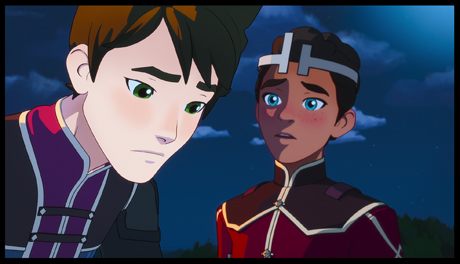
On Twitter, on February 6, 2020, Ehasz had tweeted, “On my morning walk and I think I may be changing my mind on a major character’s fate. Instead of choosing to sacrifice themselves … I think they might risk everything, but escape … let’s see if I can convince Justin.”
Nearly two-and-a-half years later, on September 1, 2022, Ehasz tweeted, “On Monday, @wildspeculation [Justin Richmond] and [I] turned in a draft of our script in which we killed off a beloved character. Yesterday, @devongiehl [Devon Giehl, Lead Writer/Producer] and #theDragonPrince writing team revised the script so that they survive … barely.”
In my October 24 interview, I asked Ehasz and Richmond about their staff convincing them to spare the character.
“True,” Ehasz says. “What we didn’t say on Twitter is they switched and we killed off—”
“—another good person,” Richmond says with a laugh.
“But that didn’t get mentioned,” Ehasz says. “But, yeah, it happens. We talked through what’s happening and what people’s fates are, what their decisions are. It’s really important even as show creators, that we not have the arrogance to be like, “Oh, we’re going to tell these characters what to do,” but instead for all of us to understand what the characters might do, to see them from different angles. When you have that kind of process, you have to be open to the fact that, ‘Hey, you had an idea for something that was going to happen, and the team sees it a different way and here’s why. And here’s what we really think would happen.’ If you’re open, then you go, ‘Okay. I’m convinced. You’re right. It’s different. It wasn’t the way we thought it was going to be when we were having our coffee this morning or whatever,’ you know?”
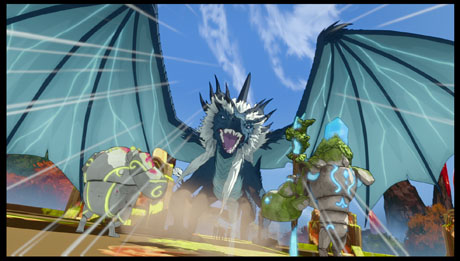
And that’s a hallmark about Wonderstorm, that Aaron Ehasz and Justin Richmond actually listen to suggestions from their cast and crew.
“We don’t just listen to it, we rely on it,” Ehasz says. “We invite the voice actors and the directors and the animators and the artists to be a part of the vision and to help us grow the vision. So obviously Justin and I have a vision for the story, and the saga, and the plan we want to build. The writing team is very close in that circle in planning the story, building out the scripts, all that.
But then, as it is a character-driven show, especially the voice actors play a great role in helping us come to an understanding of who these characters are, how they’re reacting to what’s happening around them, how they might react, what they might really be thinking, the seeds that might plant inside them. And it’s wonderful, having that creative dialogue with them as artists and all of us getting multiple perspectives to understand the characters. No one has better insight than these incredible voice actors into who their characters are and helping us find their paths.
“It’s very difficult to expose all of your story and characters to this constant, rigorous conversation,” Ehasz says. “But the results are nuanced and realistic in a way that’s hard to attain if you’re just like a solo creator trying to write it up, you know?”
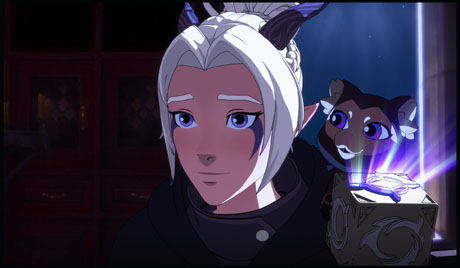
For Return of the Jedi, screenwriter Lawrence Kasdan wanted to have Luke Skywalker killed off. George Lucas balked, saying, ‘By killing somebody, I think you alienate the audience. … I have always hated that in movies, when you go along and one of the main characters gets killed. This is a fairy tale. You want everybody to live happily ever after and nothing bad happens to anybody. … The whole point of the film, the whole emotion that I am trying to get at the end of this film, is for you to be real uplifted, emotionally and spiritually, and feel absolutely good about life. That is the greatest thing that we could possibly ever do.’
The Dragon Prince has developed a base in which the fans love the characters, even villains like Claudia and Viren. Do Ehasz and Richmond share George Lucas’s beliefs in the protection of franchise characters?
“I wouldn’t say ‘you don’t kill off a franchise character’,” Ehasz says, “because part of what has happened in storytelling with Game of Thrones—even with Harry Potter—is stakes have been raised by the realities that characters face. Real life-and death-moments. That’s had a beneficial effect on storytelling and how we invest ourselves in it because we watch and we listen and anything could happen. We know it’s possible in the way storytelling works now. You know when someone’s watching something, they’re not just experiencing a set of actions and a set of events, but they’re also entering into a world and a set of feelings that they love. Respecting that point of view of someone who’s come into the franchise has a lot of implications. Sometimes the implication is, if you’re going to do something with one of these franchise characters or change them, or harm them, or kill them off, you better really understand why you’re doing it and why that outcome is still part of the experience you want.
“So I understand the way of thinking, but I don’t think it leads to the same kind of immortality armor for characters that maybe George Lucas had in mind in 1983,” Ehasz says.
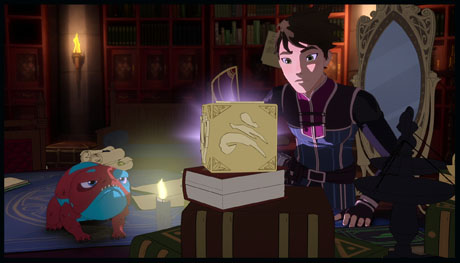
One prominent character who might get the axe is Prince Callum, now High Mage of Katolis. In the opening episode of Season Four, “Rebirthday,” we see he’s become quite advanced in the use of Primal Magic, able to sprout wings to fly at will, conjure magical umbrellas, and generate lightning balls without a single incantation. Just how powerful has he become?
“He’s Luke [Skywalker] in Empire [Strikes Back] powerful,” Ehasz says. “He’s a pretty good Jedi. He’s not just had 20 days [practicing magic] now. He’s had two years. Not only that, it’s been two years when the person he loves is gone and he’s been obsessing over it. It’s like if you went and practiced karate every day for two years, you’d probably get a black belt in that time, I think. That’s where he is. He’s been focused on it. He’s been driven. He’s really gained a lot, in particular, of Sky Magic. But he’s studied everything. He’s trying to find a breakthrough in other kinds of magic as well. He knows the spells; he knows the words. He’s learning the philosophy, the history. He’s trying to build up his ability to master more than one. As of the beginning of this season, he has not. He’s really just increased his Sky Magic ability. But he’s done some deep dives into all the other forms of magic as well.”
Is Callum at his peak?
“No. No,” Richmond says.
Can he heal yet?
“Maybe,” Richmond teases.
Granted that Season Four begins with a peace initiative from King Ezran, attempting to mend the rift between the Human kingdoms and the magical kingdoms of Xadia, would Callum have compassion enough to go to Sol Regem and cure his blindness?
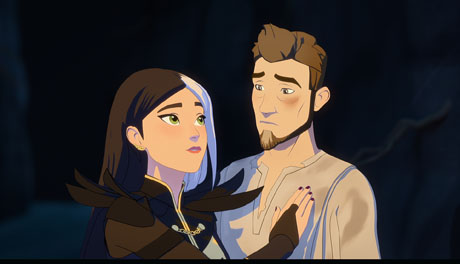
Ehasz replies, “Do you think Sol Regem wants to cure his blindness? We’ll get into that in Season Five. Sol Regem’s fate becomes very important. One assumes life has been going on as usual for him, which is, bitter dragon hanging out in his canyons near the border, just remembering the bad old days and the horrible humans and everything that happened.”
While Callum has advanced his magic skills, Crownguard Soren has been enhancing his physique with constant exercise. Could he get as muscular as Arnold Schwarzenegger in his prime?
“I could see him getting beefier,” Ehasz says. “I don’t know about Schwarzenegger level, but there’s some limits. I think he wants to be fit and strong. He naturally has a good physique. He’s a good-looking man.”
In the real world, The Dragon Prince has improved on the technical side.
“We changed a bunch of the software to make the show,” Richmond says. “So there’s new rendering technologies that have come online. They look more and more awesome as time goes on. There’s a bunch of learning that goes into all the processes.
“Literally, the whole rendering pipeline is completely different. So even though it still looks like the show, it does not work the same way at all. It’s very different behind the scenes and the lighting and rendering process to make it work. I’m not in that pipeline enough to be able to tell you the nitty gritty, but I do know that we have a totally new rendering pipeline in order to get the show out there for y’all.”
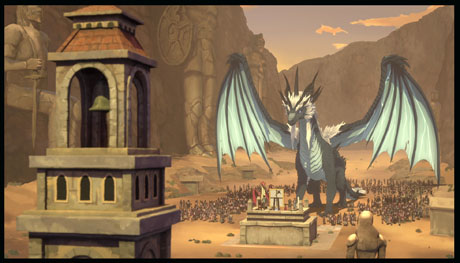
The advent of COVID did affect recording sessions. No longer could the cast perform their lines as an ensemble in a single studio, and such is still the case.
“When we started there were a lot of in-home people for sure,” Richmond says. “Jason Simpson had his own setup at his house. Jack [De Sena, the voice of Callum] had a setup at his house. And we were able to do some records. Early on you could have one person in the studio. For a long time, that’s what we did. Instead of having everybody together like we usually did in Season One through Three, there would be one person running the board and one actor in the studio, masked up and testing. And they would do all their lines, and then they would leave and they would clean the studio and then someone else would come in. Which was not as much fun for sure as going up to see everybody and be there for the records. But yeah, we did it all pretty much with people either from home or from their studio.”
“The next step was one at a time in the booth and a 15 minute wipe down of everything and everything was sterilized,” Ehasz says. “But now, they’re gonna have two at a time. Which is great, to be able to get the energy of two characters who are in a scene that requires playing off each other’s emotional state. It really makes a difference, I think, for the performance.”
Richmond says, “One of the workarounds was, we could actually record two people at once, even if they were in different locations. We could have Jack at his home studio and Jason at his home studio and they could actually record at the same time. So we did do some of that as well.”
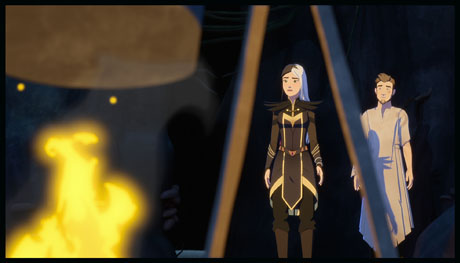
Thanks to Zoom, Ehasz and Richmond could communicate to the actors during sessions and direct their performances.
“There’s some crazy technology they use at the studio that I don’t even know the name of, where they can sync up multiple locations together,” Richmond says. “We could actually record up to three people at a time. It would be one person in one studio in Vancouver, one person at home, and another person in a studio either in Vancouver or in L.A. And that way you could actually get three people recording at the same time, even though they were all separate and isolated.”
Do the showrunners foresee a return to full ensemble recordings soon, for Season Five?
“I hope so,” Justin Richmond says with a laugh. “We’ve [already] recorded Season Five. We’re well into working on the later seasons now, because they take such a long time to go from script all the way through [the process]. It takes a year per episode. So we’re way deep into the next few seasons already.”
Regarding the release of the new season, “We’ve been waiting so long,” Aaron Ehasz says. “And I think Wonderstorm and the whole Dragon Prince team is really proud of the work that we’ve been doing, and we’re excited to share it and see what folks think and welcome them back to a couple years of more seasons, more saga, and more conversations.”
The first episode of Season Four, “Rebirthday,” bowed in the evening of October 27, 2022, on YouTube. The full season of The Dragon Prince: Mystery of Aaravos, nine episodes, is scheduled to stream today, November 3rd, 2022, on Netflix.
Click here for Part One of this interview.
Special thanks to Jennifer Greene of Illuminate-Communications.
- INTERVIEW: Aaron Ehasz, Justin Richmond on “The Dragon Prince: Mystery of Aaravos”: The Right Choice for the Voice - March 20, 2024
- INTERVIEW: “The Dragon Prince” Influences, Inspirations, and the Mystery of Simpson - March 11, 2024
- INTERVIEW: The Magic of Her Voice: Paula Burrows of “The Dragon Prince” - October 4, 2023


 November 3rd, 2022
November 3rd, 2022  W.R. Miller
W.R. Miller  Posted in
Posted in  Tags:
Tags: 






